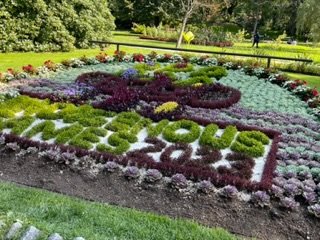When we woke up this morning and looked out onto our veranda, we were greeted with the remnants of the sunrise, with the almost full moon shining above the horizon. Such a lovely way to start the day.
At 9:20, after a hearty breakfast, we embarked on a shore excursion that took us to the Citadel, Peggy’s Cove, The Fairview Lawn Cemetery, (where some of the people who perished in the Titanic disaster are buried). and finished the day with a visit to the Halifax public gardens.
The Citadel has 4 fortifications that were constructed after the city was founded in 1749. There is a 30′ wide moat around the Citadel that has prevented any attacks during the wars. The Citadel was strategically important, as it guarded the Halifax Harbor and the Royal Navy Dockyards.
We boarded our bus again and off we went to visit Peggy’s Cove, which is nestled along the shores of St. Margaret’s Bay. The cove is a small fishing community and is one of Canada’s most popular tourist spots.
Only 35 residents live in the cove during the summer with 30 residing there during the winter months. The cove has everything needed to support their lives..a church, a school, a general store, and of course, fish and lobsters!!
The lighthouse at Peggy’s Cove is the most photographed of lighthouses, and it truly makes for a beautiful photo with the rocks that have been smoothed by the winds and the sea crashing below. Many people have perished on the black rocks below the lighthouse because a rogue wave can arise suddenly and sweep anyone who is foolish enough to try to navigate the rocks, to their death. Our guide reiterated many times… Don’t go on the black rocks!!!
One thought as to how the name Peggy’s Cove came about, was when a young child, the only survivor of a ship wreck, was rescued. She was subsequently adopted by a family living at the cove and they named her Peggy, and thus, the area became known as Peggy’s Cove. Others think the cove got its name because it is right off St Margaret’s Bay, and Peggy is a nickname for Margaret. Who knows what the true story is.
(Sadly, right near Peggy’s Cove in the entrance to St. Margaret’s Bay, was where on September 2, 1998, Swiss Air flight 111 crash landed killing all 229 souls onboard. The flight took off from JFK – its final destination being Geneva, Switzerland, when an onboard fire caused the plane to plunge into the sea. Ships, warships, aircraft, and submarines came from all over the world to aid in the retrieval of bodies and plane parts. The largest plane part that was discovered was the size of a dinner plate. That’s how enormous the devastation was. Additionally, two paintings by Picasso were on the plane and were never found. There is a monument marking the tragedy on the shore nearby.)
The Cove houses many artists and a famous one, William deGarth, not only painted beautiful watercolors of the sea, but he decided at the age of 70 to become a sculptor, and he created a mural carved in the huge granite stone that was in front of his home.
The work depicts thirty-two fishermen and their wives and children with the wings of St. Elmo, the patron saint of fisherman, protecting them. It also features the image of little Peggy, who deGarthe believed gave her name to the village.
We had a nice bowl of chowder at the Sou’Wester, a restaurant in Peggy’s cove that overlooks the water. The chowder was hearty, but the bowl was rather small and we would have enjoyed having a bit more. The meal ended with a slice of gingerbread cake doused with a generous spoonful of lemon sauce.
Walking around the cove on this beautiful day was wonderful, with the sun shining on our faces, the balmy winds at our backs, and the beauty of the sea right in front of us. It was a lovely place to visit.
The next stop on the tour wasn’t as joyful. The Fairview Lawn Cemetery holds the graves of 121 victims of the Titanic. The graves are arranged in four lines on a sloping hillside within the cemetery. The majority of headstones are small black-granite grave markers with the name of the person buried there and the date…April 15, 1912. Also inscribed on the grave markers is the number assigned to the victim when their body was recovered from the sea.
Some of the graves were nameless as the bodies were never identified, but recently, with the help of DNA, a few bodies were able to be identified and their names were inscribed on the front side of the marker. There was also a larger grave marker for the tomb of an unknown child who perished. It was a somber visit.
We then went to the Halifax Botanical Gardens, established in 1867. The garden is an example of a Victorian garden and most all of the plants and flowers were in bloom, including the dahlia and rose gardens. It was pleasant to stroll around and see the beautiful niches and flower beds that had been created.
Then it was back to the ship where, as we set sail, our captain told us that because of circumstances beyond anyone’s control, we would not be having a day at sea tomorrow but instead would be visiting Sydney in Nova Scotia, instead of visiting L’Anse aux Meadows in Newfoundland on the following day. There was a problem that arose with the pier in L’Anse aux Meadows and we would not be able to dock there.
We finished the day eating at the World Cafe with Lisa, John and a new friend Barbara, dining on sushi and surf and turf. Afterwards Allan and I decided to go to the show Duets in the theater, and were entertained by four singers serenading us with famous songs that became hits when two iconic singers sang them like… I’ve Got You Babe by Sonny and Cher, Streisand and Diamond’s rendition of You Don’t Bring Me Flowers Anymore, and Travolta and Olivia Newton John singing You’re the One That I Want. It was a little chilly in the theater, but cozy blankets were provided, so I snuggled under one of them and enjoyed the show.
It was a lovely day!

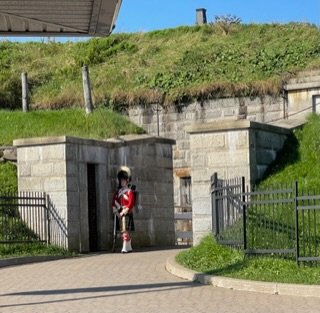
The guard at the Citadel
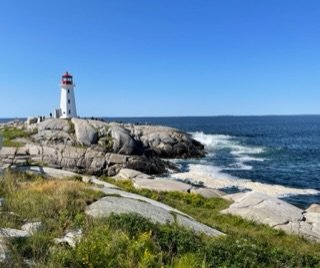
The lighthouse at Peggy’s Cove
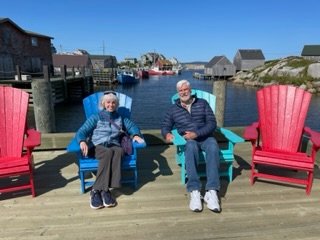
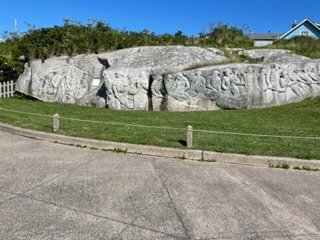
The mural carved in granite
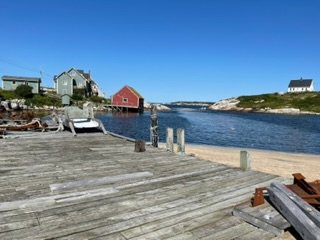
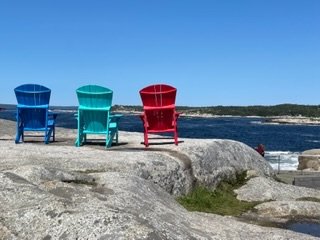
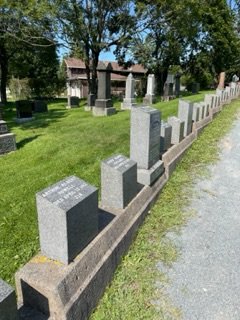
Fairview Lawn cemetery
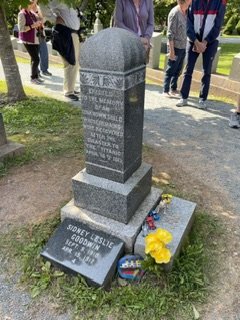
The grave of an unknown child
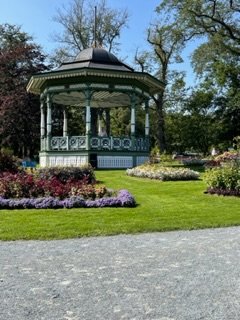
The botanical garden
